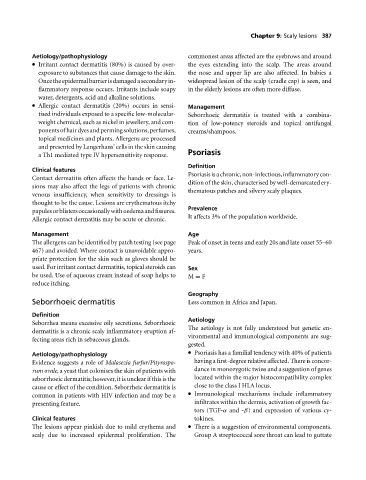Page 391 - Medicine and Surgery
P. 391
P1: FAW
BLUK007-09 BLUK007-Kendall May 12, 2005 19:59 Char Count= 0
Chapter 9: Scaly lesions 387
Aetiology/pathophysiology commonest areas affected are the eyebrows and around
Irritant contact dermatitis (80%) is caused by over- the eyes extending into the scalp. The areas around
exposure to substances that cause damage to the skin. the nose and upper lip are also affected. In babies a
Oncetheepidermalbarrierisdamagedasecondaryin- widespread lesion of the scalp (cradle cap) is seen, and
flammatory response occurs. Irritants include soapy in the elderly lesions are often more diffuse.
water, detergents, acid and alkaline solutions.
Allergic contact dermatitis (20%) occurs in sensi- Management
tised individuals exposed to a specific low-molecular- Seborrhoeic dermatitis is treated with a combina-
weight chemical, such as nickel in jewellery, and com- tion of low-potency steroids and topical antifungal
ponentsofhairdyesandpermingsolutions,perfumes, creams/shampoos.
topical medicines and plants. Allergens are processed
and presented by Langerhans’ cells in the skin causing
aTh1 mediated type IV hypersensitivity response. Psoriasis
Definition
Clinical features
Psoriasisisachronic,non-infectious,inflammatorycon-
Contact dermatitis often affects the hands or face. Le-
dition of the skin, characterised by well-demarcated ery-
sions may also affect the legs of patients with chronic
thematous patches and silvery scaly plaques.
venous insufficiency, when sensitivity to dressings is
thought to be the cause. Lesions are erythematous itchy
Prevalence
papulesorblistersoccasionallywithoedemaandfissures.
Allergic contact dermatitis may be acute or chronic. It affects 3% of the population worldwide.
Management Age
The allergens can be identified by patch testing (see page Peak of onset in teens and early 20s and late onset 55–60
467) and avoided. Where contact is unavoidable appro- years.
priate protection for the skin such as gloves should be
used. For irritant contact dermatitis, topical steroids can Sex
be used. Use of aqueous cream instead of soap helps to M = F
reduce itching.
Geography
Seborrhoeic dermatitis Less common in Africa and Japan.
Definition
Aetiology
Seborrhea means excessive oily secretions. Seborrhoeic
The aetiology is not fully understood but genetic en-
dermatitis is a chronic scaly inflammatory eruption af-
vironmental and immunological components are sug-
fecting areas rich in sebaceous glands.
gested.
Aetiology/pathophysiology Psoriasis has a familial tendency with 40% of patients
Evidence suggests a role of Malasezia furfur/Pityrospo- having a first-degree relative affected. There is concor-
rum ovale,ayeast that colonises the skin of patients with dance in monozygotic twins and a suggestion of genes
seborrhoeic dermatitis; however, it is unclear if this is the located within the major histocompatibility complex
cause or effect of the condition. Seborrheic dermatitis is close to the class I HLA locus.
common in patients with HIV infection and may be a Immunological mechanisms include inflammatory
presenting feature. infiltrates within the dermis, activation of growth fac-
tors (TGF-α and -β) and expression of various cy-
Clinical features tokines.
The lesions appear pinkish due to mild erythema and There is a suggestion of environmental components.
scaly due to increased epidermal proliferation. The Group A streptococcal sore throat can lead to guttate

